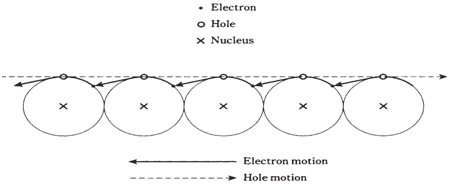Semiconductors
In semiconductor, electrons flow, but not as good as they do in a conductor. You might assume the people in the line being lazy and not too eager to pass the balls along. Some semiconductors carry electrons almost as good as good quality electrical conductors like copper or aluminum; others are almost as bad as insulating materials. The people might be just a bit sluggish, or they might be asleep.
Semiconductors are not similar to the resistors. In semiconductor, the material is treated so that it has special properties. The semiconductors include certain substances, like silicon, selenium, or gallium, which have been "doped" by the addition of impurities such as indium or antimony. Maybe you have heard of such things as gallium arsenide, metal oxides, or silicon rectifiers. Electrical conduction in these materials is a result of the motion of electrons. But, this can be a quite peculiar movement, and at times engineers speak of the movement of holes rather than electrons. A hole is a shortage of an electron-you might think of it as a positive ion-and it moves along in the direction which is opposite to the flow of electrons.

Figure-- Holes move in opposite direction from electrons in the semiconducting material.
When most charge carriers are electrons, the semiconductor is called as N-type, as electrons are negatively charged. When the charge carriers are holes, the semiconducting material is called as P-type as holes have a positive electric charge. But P-type material does pass a few electrons, and N-type material carries a few holes. In a semiconductor, the much abundant type of charge carrier is called as majority carrier. The less abundant type is called as the minority carrier.
Semiconductors are used in transistors, diodes, and integrated circuits in almost limitless variety. These substances are what make it possible for you to have a computer in a briefcase. That notebook computer, if it used vacuum tubes, would occupy a sky- scraper, because it has billions of electronic components. It would require its own power plant, and would cost thousands of dollars in electric bills every day. But the circuits are impressed microscopically onto semiconducting wafers, reducing greatly the size and power requirements.
Browse important topics or keywords of Semiconductors below: